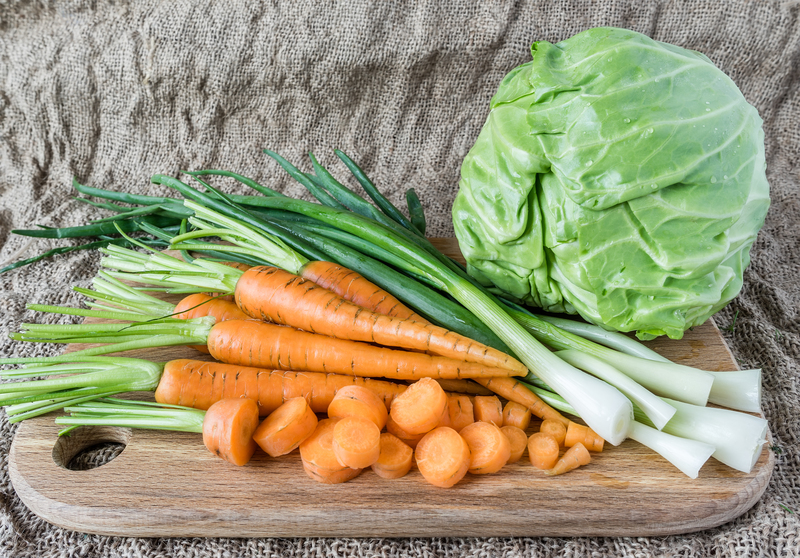Reimagine Waste as Nutrient-Rich Soil Resource
Posted on 18/08/2025

Reimagine Waste as a Nutrient-Rich Soil Resource: The Future of Sustainable Agriculture
Waste, once seen as a burden, can be transformed into a valuable asset for our environment. The concept to reimagine waste as a nutrient-rich soil resource is not only possible but essential for creating a sustainable future. This approach not only solves waste disposal issues but also enhances soil fertility, boosts crop yields, and contributes to a circular economy.
Understanding the Modern Waste Challenge
Our global society is facing a mounting waste crisis. Each year, billions of tons of organic waste end up in landfills, contributing to greenhouse gas emissions and polluting the environment. Food scraps, yard waste, manure, and agricultural byproducts represent an untapped wealth of nutrients that could be cycled back into the soil. Historically, our ancestors recycled organic waste into the earth, nourishing crops and maintaining ecological balance. Today, however, linear models of consumption and disposal have disrupted this cycle.
- Over 1.3 billion tons of food is wasted each year globally.
- Organic materials make up the largest portion of municipal solid waste.
- Landfilled organic waste emits methane, a greenhouse gas far more potent than CO2.
From Trash to Treasure: The Science Behind Soil Enrichment
Redefining waste as a nutrient-dense soil resource involves understanding the science of decomposition and nutrient cycling. Organic matter, once properly processed, can decompose into humus--a rich, dark substance that holds water and nutrients in the soil.
Composting is at the heart of this process. By managing the breakdown of organic materials, we unlock a powerful tool for regenerating soil. Microorganisms, fungi, and beneficial bacteria convert food scraps, plant residues, and manure into compost teeming with life.
- Compost improves soil structure by increasing porosity and aeration.
- It supports beneficial microbes that suppress plant diseases and pests.
- Composted waste adds vital nutrients such as nitrogen, phosphorus, potassium, and trace minerals.
Types of Waste Suitable for Soil Rejuvenation
Not all waste is suitable for soil application, but a variety of organic materials can be safely and effectively recycled into soil nutrition. Some major categories include:
- Food waste: Vegetable peels, fruit scraps, coffee grounds, eggshells, and grains.
- Yard and garden debris: Leaves, grass clippings, pruning waste, and plant trimmings.
- Agricultural residues: Crop stalks, husks, and straw.
- Livestock manure: Cow, horse, sheep, poultry, and rabbit manure after proper aging or composting.
- Paper and cardboard: Non-coated, shredded paper and cardboard add carbon and help balance compost piles.
Tip: Avoid adding meat, dairy, oils, diseased plants, or synthetic chemicals, as they can attract pests or inhibit decomposition.
Benefits of Reimagining Waste as a Soil Resource
- Enhances Soil Fertility
Compost and organic matter release slow, steady nutrients that improve crop performance and plant health. - Improves Soil Structure
The addition of organic waste increases soil porosity and water retention, reducing erosion and runoff. - Supports Soil Microbiology
A rich compost ecosystem helps foster beneficial fungi and bacteria, which enable plants to absorb nutrients more efficiently. - Reduces Waste Disposal Costs
By diverting organic waste from landfills, communities can decrease transportation and dumping fees. - Mitigates Climate Change
Decomposed organic waste in landfills releases methane. Composting such waste instead dramatically lowers greenhouse gas emissions. - Promotes Local Food Security
Healthier soils produce more resilient and nutritious crops, supporting nearby food systems.
The Role of Circular Economy in Soil Resource Management
Circular economy principles advocate closing the loop on material and energy flows. By recycling waste into nutrient-rich soil amendments, cities and farms can create self-sustaining systems that require fewer outside inputs and minimize environmental impacts. This model embodies a regenerative approach--where waste is not an endpoint, but a beginning.
Some communities have inspired sweeping change by adopting zero-waste strategies alongside soil health programs:
- Urban composting initiatives in San Francisco and Milan collect thousands of tons of food waste for local landscaping and farming.
- Rural farming cooperatives transform agricultural byproducts into fertilizer, reducing dependence on costly synthetic chemicals.
- Innovations in biogas production harvest energy from waste while creating nutrient-rich digestate for fields.
Innovative Approaches: How Technology Aids Soil Nutrient Recycling
Emerging technologies are making it easier and more efficient to reimagine waste as a powerful soil enrichment resource. Some examples include:
- In-vessel composting systems: Compact units speed up decomposition in controlled environments, ideal for urban spaces or institutions.
- Vermicomposting: Worms transform waste into castings, a super-charged soil amendment.
- Biochar production: Pyrolyzed organic matter forms a stable carbon-rich substance that improves soil fertility and sequesters carbon.
- Anaerobic digesters: Biogas facilities break down waste in the absence of oxygen, producing renewable energy and nutrient-rich slurry for farms.
Practical Steps for Homeowners and Communities
Everyone has a role to play in closing the loop between waste and soil. Whether you manage a farm, live in a rural village, or dwell within a bustling city, you can contribute to a regenerative waste-to-soil system.
-
Start Composting at Home:
- Designate a bin for kitchen scraps and yard waste.
- Layer greens (food) and browns (leaves, cardboard) for balance.
- Turn the pile regularly to aerate and promote microbial activity.
-
Join or Organize Community Compost Initiatives:
- Create neighborhood drop-off sites for organic waste collection.
- Support municipal programs targeting large-scale composting and food rescue.
-
Educate Others:
- Share resources about composting's benefits and best practices.
- Encourage local businesses and schools to participate.
-
Advocate for Pro-Soil Waste Policies:
- Lobby for bans on landfilling organic waste.
- Support legislation promoting composting, regenerative agriculture, and circular economy models.
Overcoming Challenges in Waste-to-Soil Resource Conversion
Despite the many benefits, transitioning from a waste-disposal mindset to a resource-recycling model comes with obstacles:
- Contamination: Non-organic materials, plastics, and chemicals can undermine compost quality.
- Lack of Infrastructure: Some areas need investment in collection, transportation, and processing facilities.
- Education Gaps: Communities may not understand what is compostable or how to utilize compost effectively.
- Economic Barriers: Initial costs of equipment and setup may seem daunting, though long-term savings are substantial.
Solution-Oriented Approaches Include:
- Clear labeling and public education campaigns.
- Grants and incentives for composting infrastructure.
- Research into new technologies for safely processing mixed waste streams.
Case Studies: Real-World Examples of Waste as a Soil Resource
Many forward-thinking regions and organizations offer proof that it's possible to convert waste into vibrant soil resources at scale:
-
Sweden's Composting Revolution:
The country diverts over half of its food waste to biogas facilities, with residual digestate spread on farmland as organic fertilizer. This shifts resources back into the earth and supports energy independence. -
San Francisco's Zero Waste Target:
San Francisco has made it illegal to toss compostable materials with regular trash. The city collects over 650 tons of organic waste daily, turning it into compost for area vineyards and parks. -
Community-Led Compost Hubs in India:
Several Indian cities have established local composting centers that empower neighborhoods to transform daily waste and beautify public gardens. -
On-Farm Composting in the US Midwest:
Large-scale livestock farms in states like Iowa or Wisconsin compost vast amounts of manure, bedding, and waste, producing high-value amendments that regenerate worn-out prairie soils.
Composting Myths and Facts
-
Myth: Composting is only for rural or large properties.
Fact: Apartment dwellers and city homes can compost using small bins, community gardens, or worm bins. -
Myth: Compost attracts pests.
Fact: Properly maintained piles (covered, balanced, and well-aerated) rarely become pest problems. -
Myth: Commercial fertilizers work better.
Fact: Long-term use of compost supports ecosystem health, plant vigor, and reduces chemical runoff.
Future Horizons: The Global Impact of Transforming Waste into Soil
As populations grow and environmental pressures mount, the urgency to rethink waste as an agricultural asset will only intensify. Efficient resource cycling at all scales will unlock new pathways to food security, climate resilience, and community well-being.
*Imagine a world where every banana peel, coffee ground, and autumn leaf is cherished as a building block for our future harvests.* This vision is both attainable and necessary. From household kitchens to multinational industries, the movement to turn waste into nutrient-rich soil resources promises a healthier planet for generations to come.

Conclusion: A Soil Revolution Rooted in Waste Reimagining
In summary, the journey to reimagine waste as a valuable soil resource merges tradition with innovation. By converting organic materials that were once destined for the dump into life-giving compost, we:
- Reduce landfill burdens and emissions
- Revitalize soil health and biodiversity
- Strengthen local food systems through nutrient recycling
- Promote a circular economy vision for future generations
Let us embrace the shift from a linear "throwaway culture" to a regenerative, soil-centered mindset. The soil beneath our feet is more than dirt--it is a living legacy, enriched by our conscious actions today.
Whether you're a gardener, farmer, policymaker, or educator, take the first step to reimagine waste as soil's richest resource. Join the soil revolution and help sow a more abundant, sustainable tomorrow!

